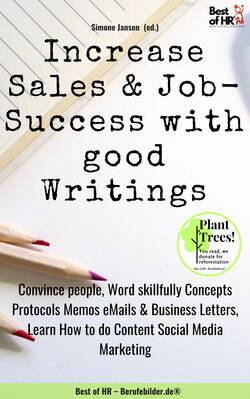Читать книгу Increase Sales & Job-Success with good Writings - Simone Janson - Страница 8
На сайте Литреса книга снята с продажи.
ОглавлениеeMails perfect write: 7 steps
// By Prof. Dr. Martin-Niels Däfler
eMails are all too often written carelessly and sent just as carelessly - after all, it does not cost anything and it should go fast. Have along eMailToday, the business unit letters as well as repressed. Therefore, it is important, too eMailWrite care to act.
Step 3: Formulate the salutation and the main part
The basic rule that you should adhere to is: One eMail must be formulated as correctly as a (paper) letter. The statements of the episode 3 apply accordingly. Step Nevertheless, there are of course some special features that you should consider.
At the beginning
The "lead" is a summary at the beginning of the press release. It contains the central statement or information on the topic and names the source ("... shares the XY GmbH with ..."). The lead should not be longer than three sentences.
Brevity is the soul of wit
The main difference between letter and eMail is - in addition to the delivery speed - the length. Mails are usually shorter than letters. Be as short as possible. However, neither sense nor politeness should be lost.
Avoid abbreviations (such as "SgDH" and "MfG"), even if they are customary. The same applies to cryptic, often English abbreviations (like "fyi" or "eom") or SMS acronyms (like "LG" or "10q").
manners
Use (even with internal eMails) friendly styles.
Avoid smileys or other icons in business correspondence. A ";-)" may well be used by trusted colleagues, but not in foreign recipients.
Structure
Make paragraphs to organize your mail.
Structure your text - use bullets or numbering. The recipient then has an easier time to answer you, as it can refer to numbers ("To point 3 I share your opinion that ...").
Zitate
Quotations are a stylistic means to make press releases interesting and varied - but boring is also not a more quirky quote.
A quotation is justified when it conveys something that only the person or institution represented by it can convey, such as an opinion or evaluation, experiences, intentions or predictions.
Step 4: Formulate the conclusion
Here, too, something similar applies to letters: At the end of your eMail the recipient should know exactly what he has to do (or not).
Finish yours eMail basically with a salutation. Give your recipient more than a simple "Greetings, Daniel Mayer" and give them a binding word, such as "Best regards," "Greetings" or "Kind regards".
Step 5: Add a signature
The signature contains your most important contact information, namely title, full name, address, telephone, fax, eMailand Internet address. Set your signature to be a maximum of 40 characters wide.
If yours eMailAddress with the prefix "mailto:" (ie "mailto: fahrlehrer@dafler.de") provided, then your address is linked and the recipient can immediately by clicking a blank eMail open to you. You should also complete your internet address.
Step 6: Check and correct your text
Many eMailWriters believe electronic mail needs no correction. Not even close! As already said, should eMails are treated with the same care as letters in form and content. This includes a conscientious correction, in terms of content, spelling, punctuation, style, comprehensibility and form.
In this context, a word about form or layout: As with all other (conventional) forms of written communication, applies also to eMails the principle: the easier, the better. Write in plain text format and do without HTML or Rich Text Format. What looks good on your PC may be distorted or misrepresented on another screen - this can not happen if yours eMail Send "unvarnished".
Also for one eMail of course applies in the end: correct! Check the correctness of content, formalities, spelling and quotations.
